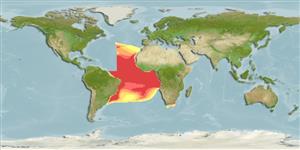>
Anguilliformes (Eels and morays) >
Serrivomeridae (Sawtooth eels)
Etymology: Serrivomer: Latin, serran, serranus, saw + Latin, vomer = ploughshare; in fishes = bone forming the front part of the roof of the mouth (1823) (Ref. 45335).
Environment: milieu / climate zone / depth range / distribution range
Ecología
marino batipelágico; rango de profundidad 0 - 2000 m (Ref. 58018). Deep-water
Eastern Atlantic: Cape Verde and Senegal (?), from Gulf of Guinea to the south. Western Atlantic: off Brazil (Ref. 47377).
Tamaño / Peso / Age
Maturity: Lm ? range ? - ? cm
Max length : 65.7 cm TL macho / no sexado; (Ref. 5237); common length : 34.0 cm TL macho / no sexado; (Ref. 57911)
A mesopelagic species feeding on crustaceans and small fishes.
Life cycle and mating behavior
Maturities | Reproducción | Spawnings | Egg(s) | Fecundities | Larva
Saldanha, L. and E. Karmovskaya, 1990. Serrivomeridae. p. 169-171. In J.C. Quero, J.C. Hureau, C. Karrer, A. Post and L. Saldanha (eds.) Check-list of the fishes of the eastern tropical Atlantic (CLOFETA). JNICT, Lisbon; SEI, Paris; and UNESCO, Paris. Vol. 1. (Ref. 5237)
IUCN Red List Status (Ref. 130435)
Threat to humans
Harmless
Human uses
Pesquerías: sin interés
Herramientas
Special reports
Download XML
Fuentes de Internet
Estimates based on models
Preferred temperature (Ref.
123201): 5 - 12.6, mean 7.2 °C (based on 73 cells).
Phylogenetic diversity index (Ref.
82804): PD
50 = 0.5059 [Uniqueness, from 0.5 = low to 2.0 = high].
Bayesian length-weight: a=0.00102 (0.00046 - 0.00225), b=3.06 (2.88 - 3.24), in cm total length, based on all LWR estimates for this body shape (Ref.
93245).
Nivel trófico (Ref.
69278): 3.8 ±0.59 se; based on food items.
Resiliencia (Ref.
120179): Medio, población duplicada en un tiempo mínimo de 1.4-4.4 años (Preliminary K or Fecundity.).
Fishing Vulnerability (Ref.
59153): Moderate to high vulnerability (46 of 100).
